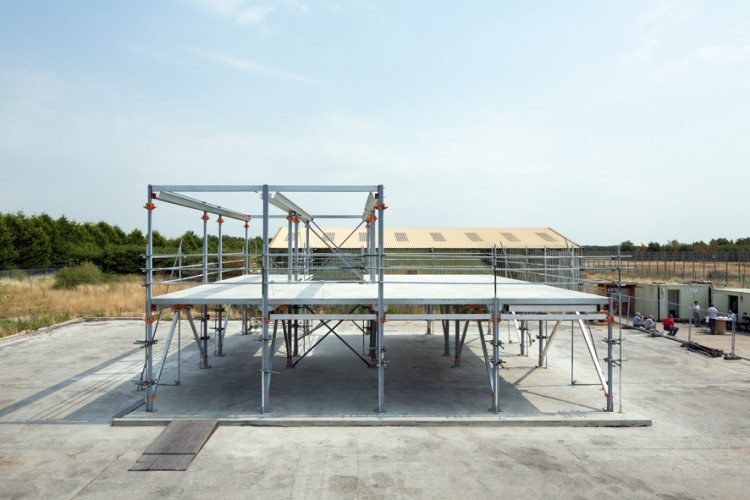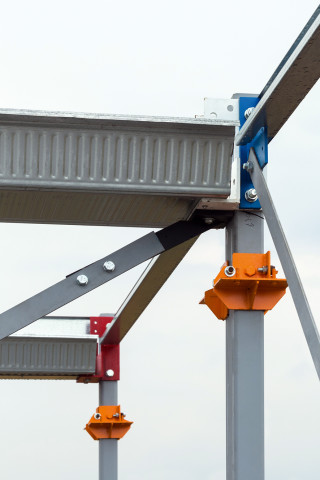Revolutions are rarely comfortable affairs. Former Cuban leader Fidel Castro (and he should know) described them as “a struggle to the death between the future and the past”.
Nevertheless, two hours spent with Jaimie Johnston, head of global systems at consultant Bryden Wood, will convince you that construction’s epic struggle between the old and the new has more at stake than ever. If his prophesies materialise, the sector is in for a very bumpy ride.
You may think you’ve heard this all before: the need to restructure procurement; create integrated teams; align with manufacturing principles. But Bryden Wood’s message is more compelling and more urgent. Crucially, the UK government is listening.
Johnston’s argument gets to the heart of this complex industry: why is it that every time a new building is commissioned, everything has to be designed from scratch? Bespoke buildings are expensive and more prone to error.
On the other hand, modular systems that are supposed to address these problems simply introduce new ones: they limit flexibility and are often tied to single manufacturers. Competition discourages collaboration and innovation between different players.
For more than two decades, Bryden Wood has been following a third direction: trying to break down the DNA of buildings to create a kit of parts that can be used universally. This has evolved into a series of ‘platforms’ – libraries of components for different types of building project, using the same principles as mobile phone or car design.
Inevitably, in this risk-averse industry, Bryden Wood’s journey has not been easy. In the early noughties, bidding for education or healthcare jobs, the consultancy often lost out to organisations with a track record of delivering familiar solutions. Clients had little appetite for new ideas.
Manufacturers of modular systems were also spooked. Roughly 15 years ago, Bryden Wood was searching for a flexible office partition system for a British Gas development. The client needed a system that could be easily and cheaply reconfigured to accommodate its fluctuating oil and gas teams. But proprietary systems tended to have specialist fixings. These could only be adjusted by manufacturers at significant cost.
Bryden Wood’s response was to design a kit of parts that could be remodelled into meeting rooms, coffee points and break-out areas by the client’s own people.
“You could literally email the estates team on a Friday, asking for a four-person meeting room on a Monday morning, and it could be done,” Johnston says.
In what was to become a familiar pattern, manufacturers whispered to the client that this was an impossible proposition. “They gave lots of technical reasons why it was never going to work,” Johnston remembers.
Frustrated, Bryden Wood decided to prove its concept and manufacture the parts itself. This triggered a sudden change of heart in established players, one of whom bid against the consultancy and won the job. “It was a nuisance for them, but if we were going to do it, they would definitely step in to stop us,” Johnston says.
The experience gave Bryden Wood confidence to start a manufacturing facility for assembling and testing prototypes. Although it gave up ownership of the factory in 2014, it continues to borrow “big sheds” to test out its ideas.
These days Bryden Wood’s integrated design and operations consultancy is active in many sectors, including education, prisons, healthcare, housing and infrastructure. Working closely with the Infrastructure and Projects Authority (IPA) it is influencing many government departments. And, with visits from high- profile clients from the USA and Japan, the slow burn revolution could finally be catching fire. The worry is that many companies are still looking the other way.
The concept of designing with a limited number of components is unsettling for architects. But Johnston dismisses fears that the system will “emasculate” design as nonsense.
He argues that architects are constrained by planning and cost considerations regardless. Most buildings have roughly 8m spans because this is optimal for structural efficiency and optimising natural daylight. And architects using Bryden Wood’s EcoCanopy system for primary schools (to date, around 35 have been built), do not appear to have been creatively straitjacketed, but have produced a wide variety of building styles and shapes.
From a manufacturing perspective, Johnston argues that platforms could create more opportunities for smaller companies. As its designs are open-source and accessible to all, potentially any manufacturer could make the components. Suppliers could be selected on the basis of their proximity to a project, reducing handling and transport costs.
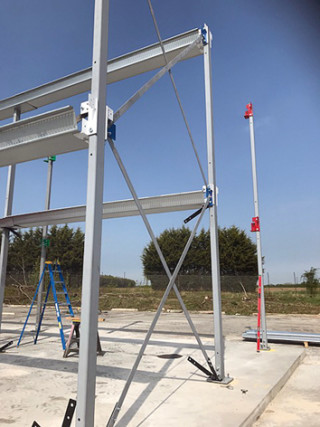
Over the longer term, Johnston believes that platforms could dramatically disrupt procurement. Clients could order components directly from suppliers, cutting out tier one contractors and reducing risk of late payment for subcontractors.
Stretching this concept to the public sector, he suggests that government departments could come together to jointly order standard components, strategically stimulating manufacturing in different regions of the UK.
It’s not hard to see why many tier one contractors, already nervous about profit margins, are uncomfortable with this suggestion. Modular manufacturers may also feel threatened: Johnston argues that platforms have logistical benefits over volumetric construction in many situations.
“With Platform 2 (used for designing, amongst other things, schools) we can get about 5,500m3 worth of superstructure into a single 40-foot container.”
He estimates that that is about 40 – 50 times more efficient than volumetric construction, where the transport of large offsite modules, each the size of a room, involves essentially delivering vast amounts of air.
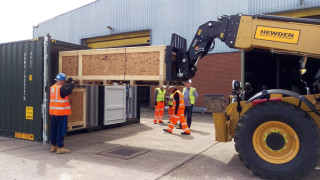
Johnston sees a time when assembly lines could be set up on building sites. This would reduce the number of times individual components would be handled. “It’s massively scalable because you don’t need big heavy investment. You can have little pop-up facilities all over the place.”
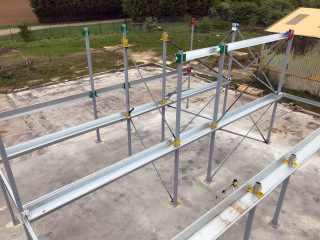
Platforms could also be a powerful means of addressing the skills shortage. With trusses and beams colour-coded so that they are fitted together with easy instructions, fewer people would be needed on site. Workers would only need to be competent in assembly, rather than highly skilled in a particular trade.
Mechanical, electrical and plumbing elements would be designed into the structure and plugged in. Qualified trades would only be required to check and sign them off.
Keen to spread the revolution, Johnston describes Bryden Wood as “quite porous” with its processes and ideas. Many client representatives have taken up semi-permanent residence within its London headquarters, causing productivity to rocket as ideas are often bounced around as part of an informal, ongoing conversation.
Is he worried that the intellectual property being stolen? Johnston shakes his head. He points out that when the iPhone was first launched, sales were poor for the first 18 months. But sales exploded when Apple opened its App Store in 2008, allowing third party developers to interact with the technology.
He is hoping that the platform system will encourage similar third-party interaction, stimulating a “huge digital ecosystem” with other organisations helping to improve the design and efficiency of components.
“The idea is that the more we make these things, the cheaper they become, and then the more people use them. So everyone gets better at platforms, then the manufacturers know that they can [invest] because people will keep buying the products.”
As for major contractors, he says diplomatically: “It will be interesting to see who steps into this space and who doesn’t.” But he is also open to the idea of new players colonising the market.
For example, logistics companies such as DHL or UPS could realise that this is “just about getting the right number of objects to the location in the right sequence”. Or Amazon could realise that “this is all about having a digital marketplace that is optimised for procurement”.
“I’m not saying that it will turn out like this. But you could imagine an organisation like Amazon building our buildings. It’s not beyond the realms of possibility,” he says.
Construction has some major challenges ahead. The collapse of Carillion has highlighted deep flaws in the sector’s business model. With Brexit looming and the skills crisis deepening, the prospect of delivering the government’s £600bn investment pipeline is coming under increasing pressure.
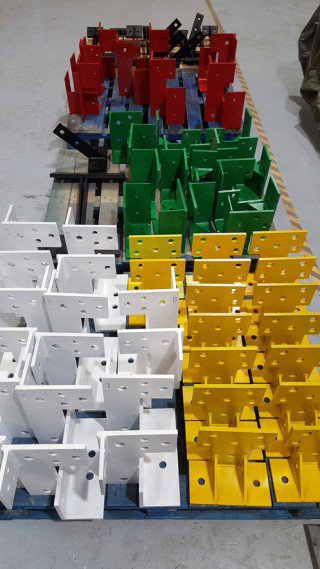
“We’ve got to do something fundamentally different: it can’t be an incremental improvement on what was done in the past. If we’re not doing this in a couple of years, then something’s gone horribly wrong,” Johnston says.
What are platforms?
.png)
A platform, in the Bryden Wood sense, is a set of components used for creating a range of product types. In manufacturing, for example, a platform could be a set of mechanical parts that can be assembled to create an engine.
The theory is that if whole sectors work with a defined number of components, rapid innovation can take place. Mass production can encourage continual improvement in their design and manufacture, speeding up product evolution.
Bryden Wood has developed three platforms catering for different sizes and span widths of building. Platform 1, for example, can be used to design classrooms, medical treatment suites and consulting rooms.
Platform 2 caters for more complex projects, such as open-plan offices and operating theatres. Platform 3 deals with larger types of structures such as warehouses and sports halls.
The platforms can also cater for varying levels of complexity in terms of mechanical, electrical and plumbing requirements. For example, you might use components from Platform 2 to build anything from a primary school (a low level of complexity) to data centres and major hospitals and research facilities, which have considerably more complex services.
The factory in a box: the view from the pharmaceutical sector
Imagine sending a fully-functioning pharmaceuticals factory in a series of shipping containers to a developing country where it is then unpacked and assembled by a team of semi-skilled locals.
This is the vision of GlaxoSmithKline which developed the ‘Factory in a Box’ concept with Bryden Wood.
The project was led by John Dyson who, at the time, was vice president and head of capital strategy and design for GSK (he is now an independent consultant and professor of human enterprise at the University of Birmingham).
GSK wanted to build in emerging markets in a way that would be cost effective, meet with international standards but also, crucially, help with the development of local communities.
“We didn’t want to just parachute things in. We wanted to be part of their development,” he says.
The concept evolved so that an entire manufacturing facility could be transported in as few as 50 shipping containers.
The components are colour-coded so that they can be easily assembled together – essentially a building kit that comes with an instruction manual. “There will be one million steps, but it you follow them, [the result] will be an antibiotics factory,” Johnston says.
Many of the components would have a QR code, particularly useful in developing countries where people may not be able to read, but do have smartphones.
“People can just ping the code and it will show them what they need to do in pictures – for example, that they need to use a spanner,” he says.

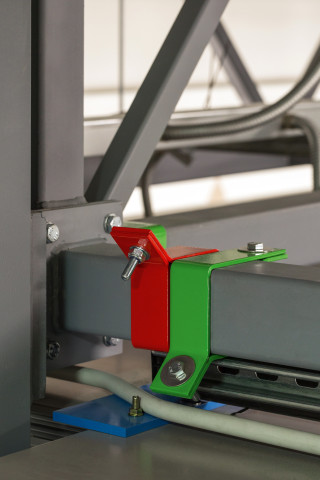
Although GSK has yet to use the Factory in a Box project in a developing country, it has demonstrated the concept at home by assembling a prototype clean-room in a warehouse in Kent. It has since created a clean-room manufacturing facility at its plant in Stevenage.
A team of ex-Ghurkhas were selected to assemble the prototype. “We wanted to take competent people who could be quickly trained in assembly,” Dyson says.
From the prototype, GSK went on to build the real thing at Stevenage. This time it used a team of just two people, one of whom was a qualified builder. Occasionally other specialists were called in to help with signing off the services but, even with this tiny team, productivity “went through the roof” according to Bryden Wood’s Jaimie Johnston.
The facility was constructed in just ten weeks, which Dyson estimates is about half the time that it would take to construct an equivalent facility using traditional methods. It was also 40% cheaper; labour costs were slashed.
The project was completed in May 2017, and since then Dyson has been sharing the concept with several pharmaceutical companies.
“The reception was generally really positive,” he says. “But the problem that industry is faced with, both from the client side and supply chain side, is that we’re not set up to deal with this sort of thing.”
He adds that major engineering companies are also resistant to the concept.
“I spent a lot of time talking to such companies when I was in GSK. They understood it. They could see it was really smart stuff. But their question was ‘how does that work for us?’ It didn’t fit with their model. They couldn’t see where they would make money out of it.”
Whilst understanding the anxiety felt by many about what could be a seismic change in the industry, he does not believe that the platform concept will lead to major job losses. It will instead free people up to meet more complex challenges.
“Not everything can be standardised. There will always be work for clever designers, because there will always be the next problem to solve. You will never run out of those.”
Platforms for prisons
Bryden Wood has been working with the Ministry of Justice to trial prototype accommodation blocks in prisons.
An important element of this pilot was to explore how it can contribute to the rehabilitation of prisoners, helping them learn new skills for the outside world. Prisoners were involved with the assembly of parts, as well as the construction and fit-out phases. They received CSCS and COSHH training, including manual handling procedures and tutorials on working safely at height.
In the first part of the process, prisoners assembled “superblocks” on a production line. Designed by Bryden Wood, these are concrete blocks with a thickly insulated centre, making them lighter than normal precast blocks and giving them a high thermal performance.
Each superblock has a hole running through it; when the interlocking blocks are stacked on top of each other, these holes align to create continuous vertical cores at 1m intervals.
Concrete is poured into each of the cores to strengthen the building. This part of the work was carried out by concrete specialists rather than prisoners.
Introducing traditional methods may seem counter-intuitive to the platform concept, but Johnston argues that a concrete pour, both for vertical cores and floor slabs, is preferable to using precast units which would be heavy to transport from the factory and would require multiple handling.
Prisoners were also involved in installation of prefabricated mechanical and electrical equipment, which was then commissioned and signed-off by qualified tradesmen.
Bryden Wood is still looking at ways of refining the process. “At the moment shutters are wheeled on a trolley, then mechanically hoisted in place. We’re working on a new concept where the shutters could be wheeled and then lifted into place by robot,” Johnston says.
He predicts a time when the robots will doing the heavy repetitive work, and humans will be working alongside them, doing the fine articulation as they fit the buildings together.
This article was first published in the November 2018 issue of The Construction Index magazine
UK readers can have their own copy of the magazine, in real paper, posted through their letterbox each month by taking out an annual subscription for just £50 a year. Click for details.
Got a story? Email news@theconstructionindex.co.uk

